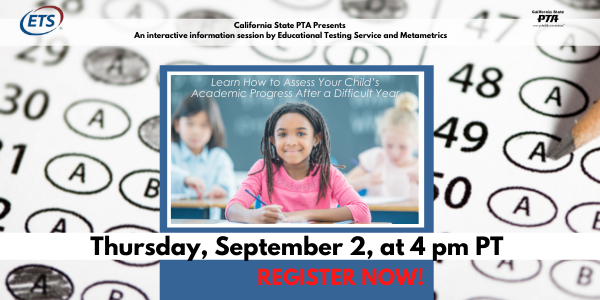Sponsored by ETS
Beginning in June, parents should be on the lookout for their child’s Student Score Report on the California Assessment of Student Performance and Progress (CAASPP). The California Department of Education in partnership with the state’s assessment developer, ETS, provides a variety of resources to help parents/caregivers understand their child’s performance on the statewide assessment. While test scores provide a common yardstick to measure student progress, it is important to remember that they provide only one measure of performance and should be considered along with the rest of a child’s learning experience.
Information on the child’s score report will help identify their academic strengths as well as where they might need a little more help. This information, along with their schoolwork and teachers’ feedback, will provide a broad picture of how a child is progressing in their academic career.
Parents can familiarize themselves with student score reports by visiting Starting Smarter where they can view a sample report that identifies each performance area and what the scores mean. For example, if a student is identified at, “Level 3 Standard Met,” that means they are performing at about grade level. The score report also shows how the child performed compared to the school and school district average. This information helps parents/caregivers and educators better understand what support the child needs to be successful in their academic journey.
Resources to Support Your Child’s Academic Progress
Now that you understand what their scores mean and have identified areas where a child might need a little more help and areas where they have excelled, there are free resources provided by the state in partnership with MetaMetrics to help them grow in reading and math. These resources can be accessed year-round.
In addition to a child’s score on the statewide assessments, the student score report will also provide a Lexile (reading) and Quantile (mathematics) measure. This information is based on the child’s reading and math ability and helps parents and educators find texts, books, and materials that are appropriately challenging to a child. Parents can access the Lexile and Quantile tools to learn more about the Lexile and Quantile measures as well as find books and materials that match their child’s comprehension level.
A Lexile (reading) measure will be shown with a number and the letter “L” at the end. Lexile measures range from below 0L for beginners to above 1600L for advanced readers. The higher the Lexile measure, the higher the students reading level. A student’s ideal choice of reading materials falls between 50L above their reported measure and 100L below their reported measure. For example, if a child has a Lexile (reading) measure of 1240L, books that fall between 1140L to 1290L are appropriate for that child. Once you’ve identified a child’s Lexile (reading) measure, you can input their Lexile range (in this case 1140L to 1290L) in the Find-a-Book tool to see suggested reading materials. For example, for a child with a Lexile range of 1140L to 1290L, books such as “Walden” by Henry David Thoreau and Herman Melville’s “Moby Dick” should be challenging enough to help them grow in reading and literature.
The Quantile (math) Measure uses a similar process. A Quantile (math) Measure will be shown as a number with a “Q” at the end. A student’s ideal math comprehension is 50Q above and 50Q below their reported measure. For example, if a child has a Quantile measure of 500Q, their math comprehension sweet spot is between 450Q to 550Q. That means math games, worksheets, and other activities that fall within that range, which you can find using the Math@Home tool, will help them grow their math skills.
Just like test scores, Lexile and Quantile Measures provide one indicator of a child’s learning and should be considered along with their other schoolwork and teacher feedback.
Parents can also visit the CAASPP parent resources website to get access to practice and training tests as well as a technology checker that is presented in the form of a game-like tool to help identify their child’s readiness for online testing. We encourage parents to use these free resources and tools all year, and especially during summer break to help students stay engaged and continue their academic progress.
California State PTA is a nonprofit and non-commercial volunteer organization and does not endorse any product, publication or business associated with sponsorship partners.

 This article was provided by our sponsor ETS. Read more about ETS
This article was provided by our sponsor ETS. Read more about ETS